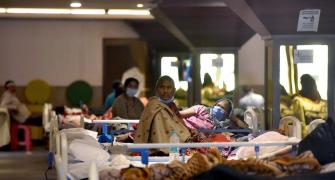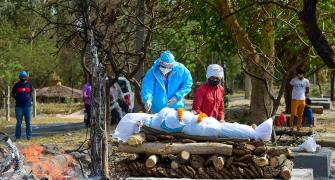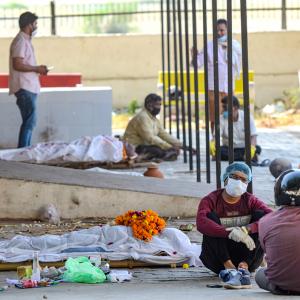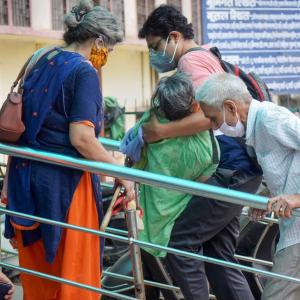The second wave of the pandemic has not only crippled medical infrastructure in terms of hospital beds, but has also led to bottlenecks in invasive ventilators and medical oxygen capacities and supplies.
Vinay Umarji and Sohini Das report.

The second wave of the pandemic has not only crippled medical infrastructure in terms of hospital beds, but has also led to bottlenecks in invasive ventilators and medical oxygen capacities and supplies.
On the one hand, the invasive ventilator industry is finding idle stock lying at certain hospitals for want of trained manpower to operate them as against other hospitals with critical cases that lack such equipment.
On the other, the medical oxygen manufacturing industry is facing a growing challenge of liquid oxygen production.
As a result, invasive ventilator manufacturers have asked state and central governments to redistribute idle stocks to hospitals that are in need and have trained manpower to operate them.
According to V Alva, founder of Skanray Technologies, a leading invasive ventilator manufacturer, the challenge is not so much shortage of equipment but of trained intensive care unit specialists, known as intensivists and respiratory technicians.
"There is an acute shortage here. We have already supplied over 30,000 ventilators to the government and another 5,000 to private facilities and can supply more as required," said Alva.
"But the country currently has only about 10,000 intensivists as against over 50,000 ventilators. There is also a non-uniform distribution of invasive ventilators," Alva added.
For another such player, Max Ventilators, demand for invasive ventilators has shot up overnight, forcing it to work on ramping up its production from 15-20 ventilators per day to 35 daily.
"One of the challenges is procuring raw materials... We are working with our 350-odd vendors for matching supply of components with the speed of ventilator production," said Ashok Patel, managing director, Max Ventilators.
"We are assisting hospitals and medical centres in improving their lower 1:10 ratio of ICU beds to ventilators, " Patel added.
"Given that such ventilators require trained manpower, at many places centres are being advised to treat patients in a non-invasive mode," Patel explained.

Similarly, medical oxygen manufacturers have sought government help in sourcing liquid oxygen and support in ramping up capacity.
The Maharashtra COVID-19 task force has advised hospitals to discontinue the use of high-flow nasal oxygen (HFNO) cannula as it guzzles oxygen.
"For patients with respiratory distress, non-invasive ventilation may be used. The high flow oxygen or HFNO machines use almost 80 litres per minute at times," said Dr Sanjay Oak, who heads the task force.
The state produces roughly 1,250 tonnes of oxygen daily. Almost all of it is getting used now.
Mumbai alone is consuming around 235 tonnes of oxygen. The city now has around 150 Covid hospitals and nursing homes.
"Patients in homecare were also using oxygen. Now we have been advised to use oxygen concentrators for home-care and not allot oxygen cylinders at home, but use them in the hospital setting," said a hospital administrator in the city who is offering home-care services.
"This would mean additional cost for the homecare patient," the administrator added.
With all its ICU ventilators in use since a couple of weeks and having tried all possible modalities to help hypoxic patients like portable BIPAP using dual limbs and High flow oxygen delivery with two flow meters, Hyderabad-based Yashoda Hospitals is anticipating more challenges.
According to Dr Venkat Raman Kola, clinical director - Department of Critical Care Medicine, Yashoda Hospitals, Hyderabad, the group has sufficient oxygen supply right now, but it is anticipating a shortage of liquid oxygen supply to its oxygen plants.
From a peak of 240 metric tonnes (MT) of medical oxygen consumed in Gujarat during the first wave, consumption has skyrocketed to a whopping 470 MT in April 2021.
Shwetanshu Patel, director of Aims Industries, one of the medical oxygen suppliers, said: "Currently, the bottleneck is in medical oxygen infrastructure and newer capacities of cylinders are unable to cope up with the rising number of patients needing oxygen.
"Going forward," Patel added, "availability of liquid oxygen is becoming a challenge."











